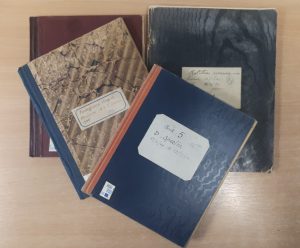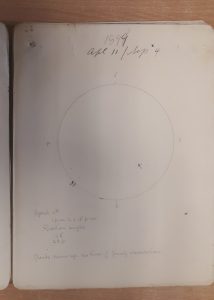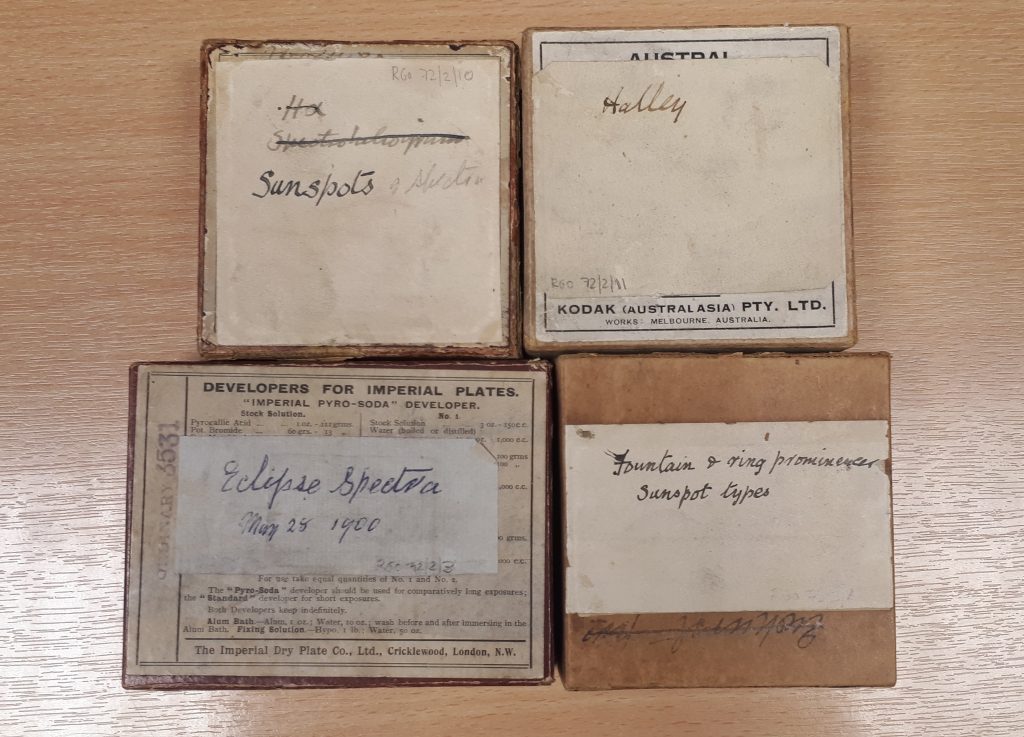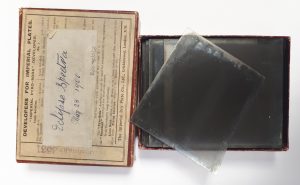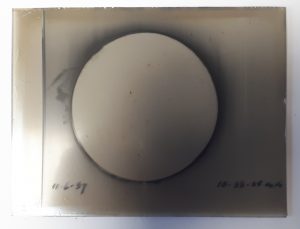Sunspot eruptions, solar spectra and fountains: the papers and glass plate negatives of astronomer, John Evershed (RGO 72)
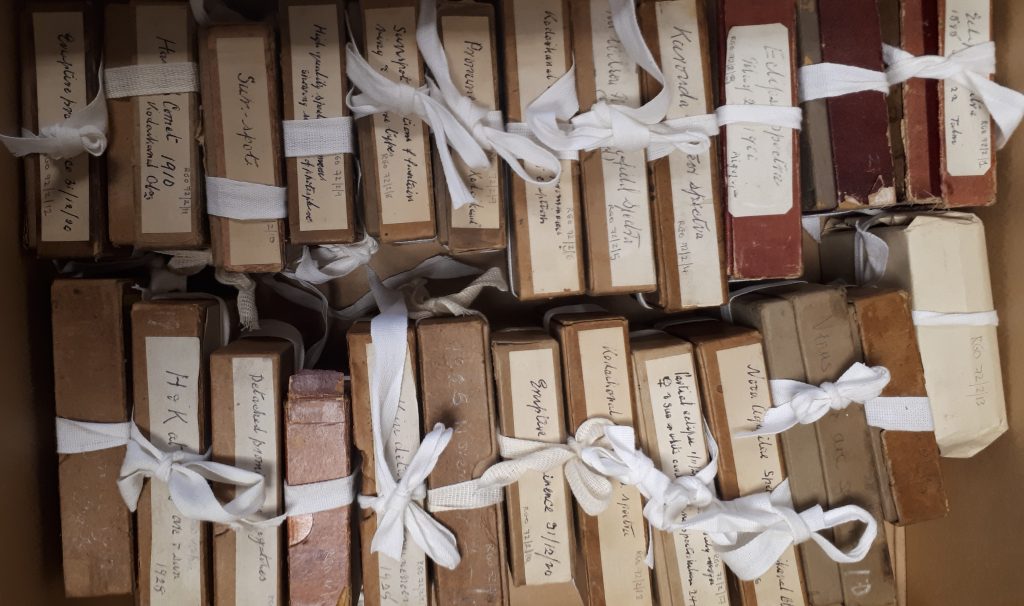
Among the recently catalogued collections of the Royal Greenwich Observatory (RGO) Archives are 7 archival boxes containing notebooks and glass plates originally belonging to British astronomer John Evershed (1864-1956). Evershed is best known for his discovery in 1909 of the horizontal motion of gases from the centres of sunspots, which flow outwards at a low level and inwards at a higher level, a phenomenon known as the Evershed effect. A founding member of the British Astronomical Association, his main areas of interest were solar observations and spectra, and he was awarded the gold medal of the Royal Astronomical Society in 1918 in recognition of his solar discoveries. The collection at RGO 72 comprises 67 notebooks documenting Evershed’s solar research between 1897 and 1950, and two boxes of glass plate negatives recording solar prominences, spectra and sunspot eruptions.
Evershed began as an amateur astronomer, observing the skies in his free time while employed with a firm of chemical manufacturers in London. His love of astronomy and capacity for instrument design was cultivated at an early age – as a child in Brighton he stole out of bed in the middle of the night to observe a comet, and he constructed his first telescope while still a schoolboy. In 1890, he became one of the founding members of the BAA and built himself a spectroscope with a battery of prisms. By 1893, he was Director of the BAA’s Section of Spectroscopy, by which time he had acquired an 18-inch telescope and spectroheliograph and was systematically observing the sun. Between 1890 and 1905 alone, he recorded the positions of 13458 solar prominences.
Aware of his interest in solar research, one of his company directors granted Evershed leave to join eclipse expeditions. He embarked on six expeditions to observe total solar eclipses: from Norway (1896), India (1898), Algeria (1900), Spain (1905), Australia (1922) and Yorkshire (1927). On his Norwegian expedition in 1896, Evershed met fellow astronomer, Mary Acworth Orr, whom he later married and co-authored works with. In 1906, he became Assistant Director of the Kodaikanal and Madras Observatories in India, later becoming Director in 1911. His discovery of the Evershed effect was facilitated by the high altitude of Kodaikanal, which allowed him to make an exceptional sequence of observations of solar spectra.
Many of the glass plate negatives catalogued at RGO 72/2 date from Evershed’s time in India where he embarked on a study of the spectrum of sunspots. The plates include images of spectra for the 1898 total eclipse, which he observed at Talni; images of spectra of Halley’s Comet as observed by Evershed at Kodaikanal in 1910; and images of prominences and sunspot eruptions taken at Kodaikanal and Kashmir (1907-1927 and 1916).
Evershed’s Solar Observatory at Ewhurst
Evershed retired in 1923 and on his return to England built his own solar observatory at Ewhurst, where most of the observations recorded in the notebooks at RGO 72 were made. The first spectrohelioscope, a type of solar telescope, had been designed by George Ellery Hale in 1924, allowing the sun to be viewed in a selected wavelength of light. Just one year later, Evershed built a specially designed large spectroheliograph at Ewhurst, and another with a high-dispersion liquid prism. There he continued to study the wavelengths of solar prominences, measuring values of the solar rotation at high levels in different latitudes and at different phases of the solar cycle.
Evershed continued to actively observe until 1953, when, at the age of 89 he finally closed down his observatory, donating some of his instruments, and it is thought, these notebooks and glass plates, to the Royal Greenwich Observatory.
Evershed’s Notebooks (RGO 72/1)
Of Evershed’s 67 solar observational notebooks, the earliest are a set of four dated 1897-1899 containing pencil drawings of solar prominences. Four more notebooks, dated 1919-1930, record Evershed’s measurements of the chromosphere, the second of the three main layers of the Sun’s atmosphere.
The main bulk of the notebooks record solar observations made at his observatory in Ewhurst, built in 1925. A set of 17 notebooks, dated 1932-1950, contain Evershed’s observations of sunspot groups to determine solar rotation. The Sun rotates on its axis once in about 27 days and this rotation was first measured using such observations of sunspots.
The remaining observational notebooks record solar intensity measurements for 1934-1940, spectrohelioscopic measurements for 1930-1938, and measurements of Doppler Shifts, recording Evershed’s interest in both sunspots and spectra of all sorts.
Evershed’s Glass Plates (RGO 72/2)
Alongside the notebooks are two archival boxes containing 48 sets of glass plate negatives. The glass plates are small and square (8.2 x 8.2 cm) or rectangular (some measuring little more than 3 x 8 cm). Many have brief captions or dates written on them in ink, presumably in Evershed’s hand.
The plates were originally stored in non-archival cardboard boxes, which afforded little protection against either breakages or acid-damage. As a result, a number have faded or suffered damage through time. The whole glass plate collection will ultimately be re-housed by our Conservation and Collection Care team, with each plate individually packaged in a loosely fitting buffered paper sleeve, and placed in archival boxes with added supports.
The photographs captured are fascinating. They include dramatic images of sunspot eruptions and solar prominences, including a set with the exciting title, ‘Sunspot eruptions: fountain ring & explosive types’. There are also images of spectra for solar eclipses, starting with the total solar eclipse of 22nd January 1898 which Evershed observed in India, closely followed by spectra for the eclipse of 28th May 1900, observed in Algeria.
Beyond his solar work, the glass plates include spectacular images of Halley’s Comet, the Andromeda Nebula and Venus; Karouda Meteor spectra; Evershed’s measurements of solar spectrograms made at Mount Wilson, California by G.E. Hale; and spectra of Nova Aquilae observed by Evershed between 13th and 21st June 1918, just days after this bright nova was first observed in the constellation Aquila by Z. Laskowski on 8th June 1918.
Accessing the collection
The notebooks and plates at RGO 72 form an important record of John Evershed’s pioneering work in studying sunspots and solar spectra, and showcase his important contribution to the field of solar studies. A full catalogue for the John Evershed Papers (RGO 72) is available on ArchiveSearch. The collection can be accessed in the Manuscripts Reading Room with a valid reader’s ticket.

